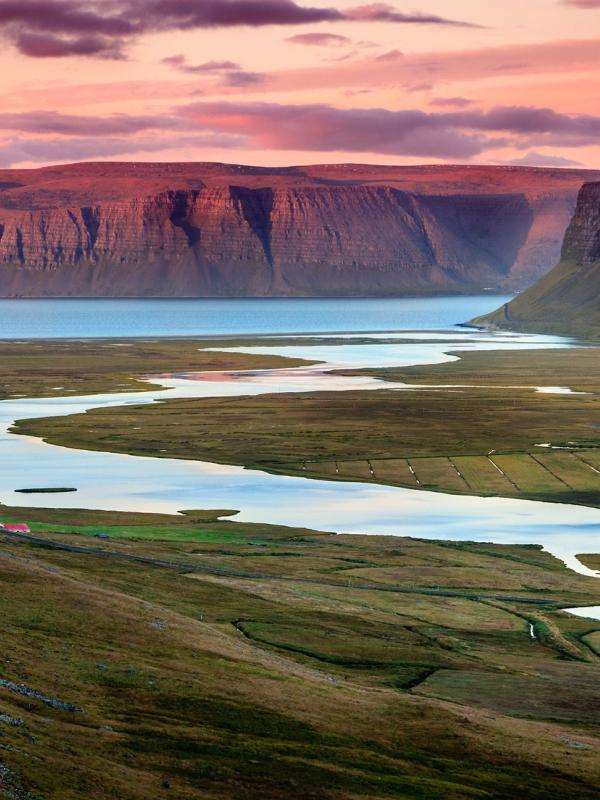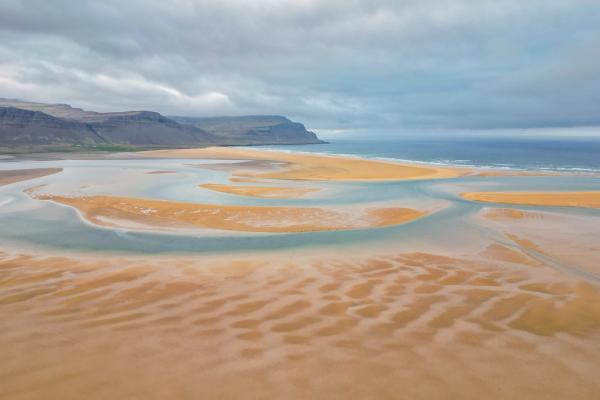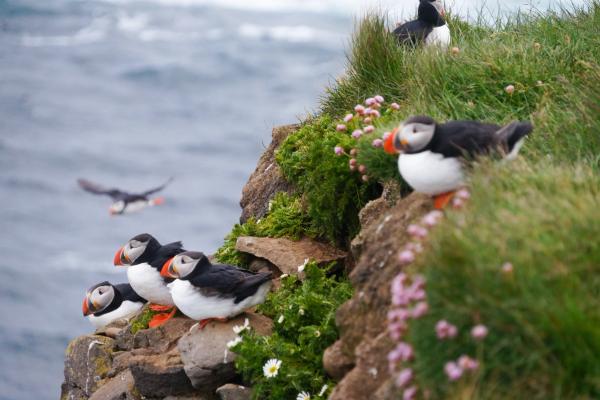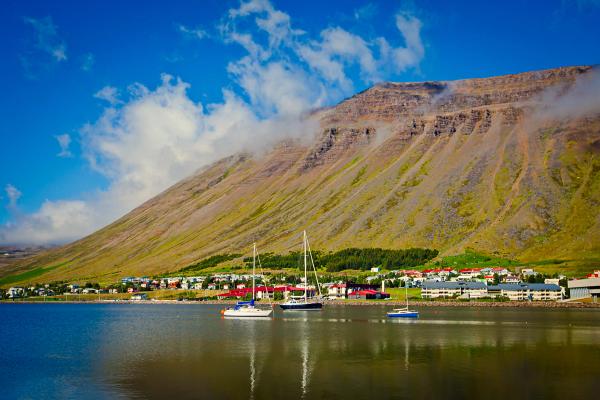
Top 10 Things to See and Do in the Westfjords
The Westfjords, Iceland's northwest treasure, is a great destination for travelers seeking a one-of-a-kind Icelandic experience. The area boasts stunning fjords, massive flat-topped mountains, amazing bird cliffs, well-maintained hiking trails, and beautiful waterfalls, among the many other wonders of nature.
This large peninsula is one of Iceland's most remote and sparsely populated tourist destinations. Few people have it in their travel plans, so if you want a peaceful and serene setting for your campervan trips, this is the place to go. Whether you're visiting the Westfjords with your family, friends or alone, you'll find a great number of places that will suit your interests.
1. Soak in the Hellulaug Hot Spring
On the south coast of the Westfjords is the Hellulaug hot spring, which bubbles continuously from the ground all year long. It is located just off Route 62, near the Flókalundur Hotel and Campground, and offers a spectacular view of Vatnsfjörður. Although the springs in the area are marked on the highway, many people are unaware of Hellulaug.
The spring is approximately 4 meters wide, with a temperature of around 38°C. Up to eight people can fit in the hot pot. A small parking lot is located above the Hellulaug spring, and there is a wall behind the pool, which serves as a changing area. When next you’re on a camping trip in Iceland, consider taking a dip in this warm and refreshing pool.
2. Visit Rauðisandur Beach
Rauðisandur, which translates to "red sand,” is a 10-kilometer stretch of sand in the south of Westfjords. This beach is one of the unique destinations in the region, as it stands out from the black sand beaches usually found in Iceland. The color of the beach changes depending on the weather and season, ranging from yellow, red, orange, and sometimes even pink. Over the years, broken scallop shells have constantly accumulated on the beach, and this is the reason why the color varies.
To get there, there’s a steep, unpaved road that crosses over the mountains. It can be difficult to navigate in poor weather, so be cautious as you drive down. The Melanes Campsite at the eastern end of the beach is a fantastic and remote camping spot to stay. There is also a French café, Franska Kaffihúsið, where you can enjoy seafood and a hot cup of coffee.

3. Admire the Birds at Látrabjarg Cliffs
The towering and steep Látrabjarg cliffs, located at the island's westernmost point, are the largest bird cliffs in Westfjords and one of the largest in Europe. The cliffs extend 14 kilometers along the coast, rising to the towering height of 440 meters at the tallest section. During the summer, thousands of birds, including northern gannets, guillemots, fulmars, auks, and razorbills, flock to the area. In fact, the Látrabjarg cliffs are home to up to 40% of the world's Razorbill population.
If you're visiting this area, keep an eye out for the ever-adorable puffins. You can often spot them along the edge of the cliff, and they show minimal fear of humans unless you try to touch them. While it is possible to go extremely near the birds for snapshots, be extremely careful. Burrows dug into the earth by the puffins can make it loose and susceptible to collapse. The proper technique is to get down on your belly to spread out your weight before crawling to the cliff’s edge.

4. Visit the Icelandic Sea Monster Museum in Bíldudalur
The Icelandic Sea Monster Museum is one of Iceland's most fascinating museums. Sea monsters have long been a part of Icelandic tradition, and there are various documented stories of them all over the country. This museum, located in Bíldudalur on the shores of Arnarfjörður, plays a significant role in providing insight into the folklore of Iceland.
The museum showcases firsthand stories from eyewitnesses throughout Iceland's history and academic theories on sea monsters. It also allows visitors to watch these remarkable sea monsters come to life through an interactive multimedia display. While the museum is ideal for kids, some of the large exhibits might freak them out. A small cafe that offers a range of drinks and snacks is available on-site.
5. Enjoy a Swim at Reykjafjarðarlaug Hot Pool
Reykjafjarðarlaug is located approximately 100 meters from Route 63 in the southwest area of Westfjords. Here, you will find two pools: a natural hot pool with a temperature of around 45°C and a man-made swimming pool that has the hot pool as its primary source. This area is truly a fantastic place to visit for people who prefer quiet locations to overcrowded beaches and towns.
While swimming in this natural hot pool, you can enjoy the beauty of the mountains in the background, and a breathtaking view of Arnarfjörður. Unlike many other natural hot pools, this spot offers access to changing rooms for both men and women (however, there are no showers). Entrance to the Reykjafjarðarlaug is free, and the pools are open all year long.
6. Marvel at Dynjandi Waterfall
If you're on a camper van trip in the Westfjords, then Dynjandi should be at the top of your bucket list. This is the region’s biggest waterfall, a rushing force of water that tumbles down several rocky steps carved into the cliffs. The result is a series of waterfalls that charge down all the way to the shores of the fjord. It’s so breathtaking that many Westfjords locals consider it to be Iceland's most beautiful waterfall. It’s a must-see when you’re in the Westfjords.
Dynjandi is around 100 meters high, 30 meters wide at the top, and 60 meters wide at the bottom, giving it a tapering appearance. While each of the six waterfalls beneath the main one is a beauty on its own, Dynjandi's overall impact is enhanced by the combined effect of all seven waterfalls. You can access the top by taking a 15-minute walk from a parking area off Route 60.
7. Check Out the Oldest Bookstore in Iceland
The Old Bookstore in Flateyri is a must-see for book enthusiasts interested in learning more about the country's history. This store, which was opened in 1914, is considered Iceland's oldest original store. The fact that it has maintained its authenticity since its inception makes it remarkable. You’ll find here an extensive collection of books and other memorabilia that preserve the store’s history. It is run by Eythor Jóvonsson, who is the great-grandson of the founders, Jón Eyjólfsson and Gudrún Arnbjarnardóttir.
While visiting, you may buy new books by Icelandic authors, as well as souvenirs, postcards, and second-hand books that are priced according to their weight. Next to the bookstore is the apartment of the founders, who both lived in it since 1915; it has remained untouched since Jón's death in 1950.
8. Visit Ísafjörður, Capital of the Westfjords
With a population of around 2,600, Ísafjörður is the largest town in the Westfjords. The town offers more lodging options and general facilities than anywhere else in the region. Visitors can also enjoy several attractions, including the popular Ísafjörður Culture House and Maritime Museum.
There’s also a golf course for those interested, as well as some of Iceland's most historic buildings, dating back to the 18th century. If you're looking for some extra fun activities, stay at the campsite for a few nights and enjoy hiking, biking, birdwatching, kayaking, and even skiing in the winter.

9. Hike in the Hornstrandir Nature Reserve
Hornstrandir Nature Reserve, in the far northwestern region of the Westfjords, is one of Iceland's most remote tourist destinations. The area has been uninhabited since the 1950s and has been well-protected since 1975, when it was designated as a wildlife reserve. Rugged mountain slopes, flowery fields, sea cliffs, and ice characterize the terrain of this reserve, making it a favorite destination for adventure seekers.
Due to the unpredictability of the weather, this location receives very few visitors in the winter. Early summer is, therefore, the best time to visit. To get to the reserve, you must first travel to Ísafjörður before boarding a ferry. It’s a place designed for serious hikers; you must take everything you need with you, as there are no services in the area.

10. Visit the Museum of Icelandic Witchcraft and Sorcery
The Museum of Icelandic Witchcraft and Sorcery is an award-winning museum in Hólmavík, located on the east side of Westfjords. The museum has a multilingual collection of guides that tell historical facts and frightening stories about what happened in Iceland in the 17th century when the country went through a period of trialing witches for practicing magic and sorcery.
In this museum, you’ll get to see mystic exhibitions such as magical staves, milk-sucking demons, a zombie emerging from the earth, and the astonishing necropants–a pair of pants created from the skin of a dead man, used in a spell that reportedly grants the caster endless wealth. Whatever you do, don't miss the detailed descriptions of the esoteric spells and rituals.
Conclusion
The Westfjords are one of Iceland’s most special regions, packed with incredible sights and hidden gems that most travelers don’t get to see. With warm hot springs, stunning beaches, massive waterfalls, and steep cliffs filled with birds, this area has so much to explore.
Hiking in remote nature reserves, visiting quirky museums, and soaking in peaceful hot pools are just a few of the experiences waiting here. The journey might take some extra effort, but that’s what makes it so special. For those looking to see a quieter, wilder side of Iceland, the Westfjords are well worth the trip.
